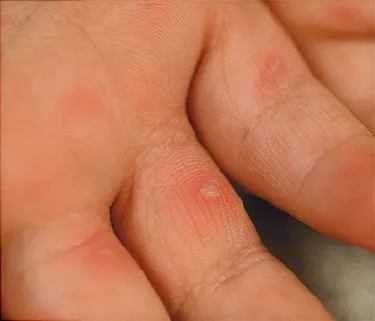Content Row
Health Services
»
Hand, Foot and Mouth Disease
HAND, FOOT AND MOUTH DISEASE


What is hand, foot and mouth disease (HFMD)?
Hand, foot, and mouth disease (HFMD) is a viral illness that affects mainly infants and children. Symptoms include fever, skin rash, and red spots or sores in the mouth. HFMD is not related to foot-andmouth disease (also called hoof-and-mouth disease). Although the two diseases have similar names, they are caused by different viruses. HFMD only affects people, and foot-and-mouth disease only affects animals such as cattle, pigs, and sheep.
What causes HFMD?
HFMD is caused by several different viruses that belong to the enterovirus group, including coxsackieviruses and enterovirus 71. Coxsackievirus A16 is a very common cause of HFMD. Enterovirus 71 has caused several large outbreaks of HFMD in Asia. Some patients in HFMD outbreaks caused by enterovirus 71 have had serious illness.
Who is at risk of getting HFMD?
HFMD is common in infants and children under age 10, but can also affect older children, teenagers and adults. A person can be infected if they are exposed to a type of enterovirus that they’ve never been exposed to before. However, some people who are infected do not get sick.
What are the symptoms of HFMD?
The first symptoms of HFMD are usually fever, sore throat, loss of appetite, and feeling sick (malaise). One to two days after fever begins, small red spots develop in the mouth on the inside of the cheek, gums, and tongue. The spots may turn into blisters or ulcers. A skin rash can also develops on the hands, feet, and buttocks, and sometimes on the arms and legs. The rash includes raised or flat red spots and blisters. Not everyone with HFMD develops all of these symptoms.
HFMD symptoms are usually mild and resolve on their own in 7 to 10 days. However, in rare cases, HFMD can cause complications. One complication is viral (aseptic) meningitis. Symptoms of viral meningitis include headache, stiff neck, and fever. People with viral meningitis sometimes need to be hospitalized. Very rarely, HFMD can also cause encephalitis (swelling of the brain). Encephalitis is a severe disease that can be fatal.
How is HFMD spread?
HFMD is commonly spread by contact with an infected person’s stool, nose and throat discharge, blister fluid, or saliva. Virus is often passed when an infected person’s unwashed hands touch someone else or contaminate a surface. The viruses that cause HFMD can survive for long periods on environmental surfaces.
A person with HFMD is most contagious during the first week of illness, but may continue to be contagious for several weeks after their symptoms are gone.
How soon do symptoms appear?
Symptoms of HFMD usually appear 3–7 days after initial exposure and infection.
How is HFMD diagnosed?
Doctors usually diagnose HFMD based on the patient’s age, symptoms, and type and location of rash or sores. Generally, a doctor does not need a test to diagnose HFMD. Sometimes, he or she may take a throat swab or collect a sample of blister fluid or stool to test what kind of enterovirus is causing illness.
How is HFMD treated?
There is no specific treatment. Almost all children with HFMD recover on their own. People with HFMD should rest and drink liquids to prevent dehydration. A health care provider may also recommend medications to control fever and pain.
Sores in the mouth can make swallowing painful and difficult, and some children may refuse to drink fluids for this reason. If reluctance to drink causes serious dehydration, treatment with intravenous fluids may be needed.
How can HFMD be prevented?
Everyone in the household of a person with HFMD should thoroughly wash their hands with soap and water after using the toilet, changing diapers, or having any contact with nose and throat discharge, stool, or blister fluid. Toys and surfaces should first be washed with soap and water, and then cleaned with a dilute solution of bleach (add ¼ cup bleach to one gallon of water). Children with HFMD should be kept home from daycare or school until their fever goes away and their mouth sores have healed. Adults with illness should stay home from work until symptoms resolve.
Can my child to to school or child care with Hand, Foot and Mouth Disease?
Yes, except for when:
- The child is not feeling well enough to participate in class or has a fever.
- The teacher or child care provider feels he or she cannot take care of the child without compromising care for the other children in the class. Excessive drooling from mouth sores might be a problem that would necessitate the child staying home.
- The child has many open blisters. It usually takes about 7 days for the blisters to dry up..
- The rash or blisters are very itchy or painful and would prevent the child from being able to participate.
- The child meets other exclusion criteria.
Note: Exclusion will not reduce the spread of this disease because children can spread the virus even if they have no symptoms and the virus may be present in the stool for weeks after the symptoms are gone.
When can my child go back to school or child care?
A child can return to school or child care after all of the exclusion criteria (listed above) are resolved and the child feels well enough to participate. Talk with your child's pediatrician if you are not sure when your child should return.
How can I learn more about HFMD? If you have questions about HFMD, please contact your doctor or local health department
STATE OF CALIFORNIA—HEALTH AND HUMAN SERVICES AGENCY Department of Public Health Division of Communicable Disease Control
NOT YET CHECKED
12/27/25 11:42 PM
